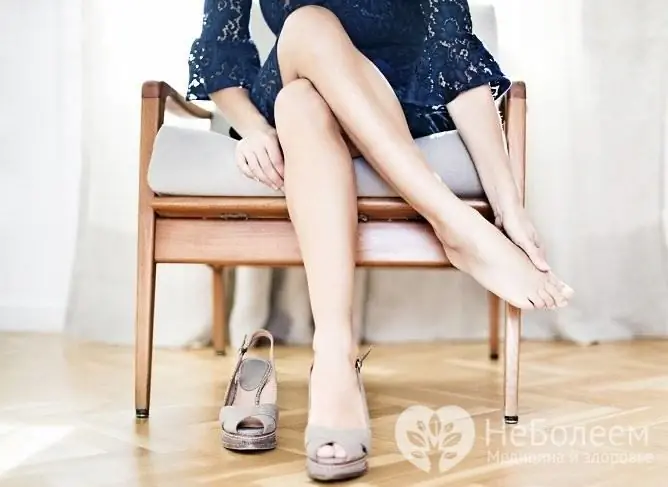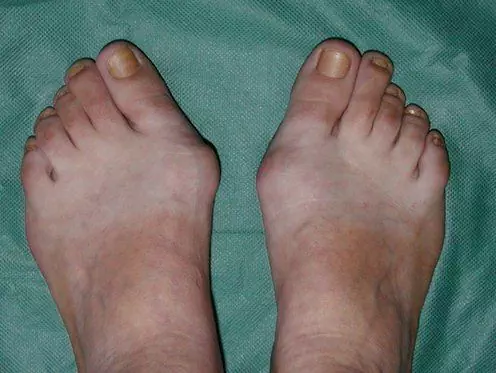Numbness of toes: causes and what to do
The content of the article:
- Why is there numbness in the toes?
- Diagnostics
- Toes go numb - what to do?
- How to treat toe numbness at home
- Prevention
- Video
Numbness of the toes (impaired sensitivity, paresthesia) is a condition characterized by a violation of the human body's ability to correctly perceive various irritations from its own tissues or the external environment. It is often combined with tingling, pain or burning, redness or pale skin.

In most cases, uncomfortable, crushing shoes are the cause of numbness in the toes.
Why is there numbness in the toes?
Short-term sensory impairment is usually caused by an uncomfortable position of the lower limb or mechanical compression of the foot with narrow shoes. At the same time, blood vessels are compressed, blood supply to soft tissues is disrupted, which leads to the occurrence of paresthesia. When you change your posture or remove tight shoes, blood flow is quickly restored and the discomfort disappears.
The table shows the main diseases, one of the symptoms of which may be a violation of the sensitivity of the lower extremities:
| Causes of numbness in toes | Clinical signs |
| Osteochondrosis of the lumbar spine | Degenerative-dystrophic processes lead to a thinning of the intervertebral discs and a decrease in their height. As a result, compression of the sciatic nerve develops over time. Initially, the patient has stripe pain along the inside or outside of the leg. Then, violations of the sensitivity of the fingers, foot, heel and ankle join. |
| Acute disorders of cerebral circulation | If a patient's fingers on the left or right leg become numb and symptoms such as disorientation, impaired coordination of movements, hemiparesis, blurred speech, severe headache are noted, this allows him to suspect the development of a transient ischemic attack or stroke. |
| Multiple sclerosis | Loss of sensation is usually combined with impaired motor function of the limbs. |
| Tumor processes | Large malignant tumors of the pelvic organs compress blood vessels. As a result, there is a violation of the blood circulation of the lower extremities, which causes numbness in the feet. In addition, the patient has an increasing general weakness, weight loss, and decreased appetite. |
| Polyneuropathy | Various diseases (HIV infection, diabetes mellitus, alcoholism, hypovitaminosis of B vitamins, renal failure) can lead to damage to the peripheral nerves. Paresthesia is usually combined with progressive muscle atrophy, trophic ulcers, increased nail fragility. |
| Articular apparatus lesions |
Various diseases of the joints (rheumatoid, psoriatic arthritis, deforming osteoarthritis, gout) are often accompanied by soft tissue edema. It causes compression of nerve endings and, as a result, sensory disturbances. In addition, patients have other symptoms: pain in the area of the affected joints, impaired mobility, redness of the skin. |
| Raynaud's disease | The development of the disease is based on violations of blood flow through the arteries. The legs take on a characteristic appearance. The skin is pale, cold to the touch. Often there are trophic ulcers that are resistant to treatment. |
| Corns | Most often located on the pads under the middle toe or little toe. Are areas of thickening of the skin of a grayish tint, dense to the touch. Painful when walking. |
| Frostbite | Frostbite occurs most frequently on the fingertips. The damaged areas turn white. Their sensitivity is impaired, pain arises. With significant frostbite, there are characteristic blisters on the skin. |
Diagnostics
As mentioned above, short-term paresthesias of the toes are most often caused by either an uncomfortable position of the body, or compression by uncomfortable shoes. Therefore, if, for example, your little toe grows numb when wearing tight dress shoes, and this feeling quickly passes when you change shoes, there is nothing to worry about. But if sensitivity disorders persist for a long time, you should definitely consult a doctor.
It is necessary to understand that paresthesias can occur against the background of pathological processes. Therefore, only a specialist can make the correct diagnosis and prescribe the necessary treatment after a full examination. Depending on the specific clinical situation, it may include:
- MRI, CT, x-ray of the lumbosacral spine;
- biochemical blood test to determine the concentration of glucose, urea, creatinine, uric acid, C-reactive protein;
- radiography of the feet;
- MSCT of the brain;
- blood test for the presence of tumor markers;
- Ultrasound of the pelvic organs;
- Doppler ultrasonography of the vessels of the lower extremities.
If necessary, the patient is consulted by narrow specialists:
- traumatologist;
- orthopedist;
- rheumatologist;
- neurologist;
- oncologist;
- nephrologist;
- vascular surgeon.
Toes go numb - what to do?
It is impossible to give an unambiguous answer to this question, since the actions depend on the cause of the unpleasant sensations. Only a doctor, after conducting an examination and making the correct diagnosis, can prescribe this or that drug. For example, in hypovitaminosis, patients are shown to take B vitamins, in gout - Allopurinol, and in Raynaud's disease - vasodilators.
How to treat toe numbness at home
To improve blood flow in the legs, it is recommended to take warm baths daily. Algorithm of the procedure:
- Sit in a chair or chair in a comfortable position.
- Take off your shoes and move your foot up and down, left and right (10-15 repetitions each);
- Dip your feet into a basin of warm water and hold them for 10-15 minutes. To enhance the effect, pine needles extract can be added to the water.
- Dry your feet with a clean towel, using gentle dabbing movements. Pay particular attention to the skin between your toes.
- Apply a nourishing cream to your skin and massage your feet.

Foot soaks can help with toes numbness
Traditional medicine offers many recipes for the treatment of paresthesias. Some of them are quite effective, but should only be used after consulting a doctor. Let's consider the most popular ones:
- Infusion of sweet clover. Pour a small pinch of herbs with a glass of boiling water. Insist for 15-20 minutes. Strain and take half a glass 3 times a day.
- Camphor ointment with eucalyptus oil. Add a few drops of eucalyptus oil to a jar of pharmacy camphor ointment and mix thoroughly with a wooden stick. The ointment is applied to the problem area with light massaging movements at night.
- Pumpkin compress. Bake a piece of pumpkin and puree with a blender. Apply the resulting mass warm to the feet, cover with wax paper and wrap with a woolen scarf. Keep the compress for at least 2-3 hours.
- Pepper oil. Add 10 g of black ground pepper to 100 ml of sunflower oil. Heat the mixture over low heat for 10 minutes. Strain. Rub into problem areas 2 times a day.
- Pepper tincture. Grind 3 medium pickled cucumbers and a red hot pepper pod. Pour the resulting mass with a liter of good vodka. Insist in a dark place for 10 days, shaking occasionally. Strain. Use to rub on numb areas as needed.
Prevention
To prevent numbness of the toes, you must:
- to live an active lifestyle;
- give up bad habits (smoking, drinking alcoholic beverages);
- adhere to a balanced diet;
- refuse to wear uncomfortable shoes;
- timely treat infectious and somatic diseases.
Video
We offer for viewing a video on the topic of the article.

Elena Minkina Doctor anesthesiologist-resuscitator About the author
Education: graduated from the Tashkent State Medical Institute, specializing in general medicine in 1991. Repeatedly passed refresher courses.
Work experience: anesthesiologist-resuscitator of the city maternity complex, resuscitator of the hemodialysis department.
Found a mistake in the text? Select it and press Ctrl + Enter.







